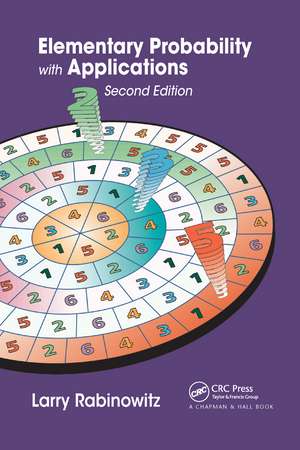Elementary Probability with Applications
Autor Larry Rabinowitzen Limba Engleză Paperback – 30 sep 2020
The text explains how probability models with underlying assumptions are used to model actual situations. It contains examples of probability models as they relate to:
- Bloc voting
- Population genetics
- Doubling strategies in casinos
- Machine reliability
- Airline management
- Cryptology
- Blood testing
- Dogs resembling owners
- Drug detection
- Jury verdicts
- Coincidences
- Number of concert hall aisles
- 2000 U.S. presidential election
- Points after deuce in tennis
- Tests regarding intelligent dogs
- Music composition
Based on the author’s course at The College of William and Mary, the text can be used in a one-semester or one-quarter course in discrete probability with a strong emphasis on applications. By studying the book, students will appreciate the subject of probability and its applications and develop their problem-solving and reasoning skills.
| Toate formatele și edițiile | Preț | Express |
|---|---|---|
| Paperback (2) | 325.34 lei 43-57 zile | |
| CRC Press – 30 sep 2020 | 325.34 lei 43-57 zile | |
| CRC Press – 7 oct 2019 | 367.73 lei 43-57 zile |
Preț: 325.34 lei
Preț vechi: 371.71 lei
-12% Nou
Puncte Express: 488
Preț estimativ în valută:
62.25€ • 65.17$ • 51.51£
62.25€ • 65.17$ • 51.51£
Carte tipărită la comandă
Livrare economică 07-21 aprilie
Preluare comenzi: 021 569.72.76
Specificații
ISBN-13: 9780367658281
ISBN-10: 0367658283
Pagini: 218
Dimensiuni: 156 x 234 x 23 mm
Greutate: 0.45 kg
Ediția:2 New edition
Editura: CRC Press
Colecția Chapman and Hall/CRC
ISBN-10: 0367658283
Pagini: 218
Dimensiuni: 156 x 234 x 23 mm
Greutate: 0.45 kg
Ediția:2 New edition
Editura: CRC Press
Colecția Chapman and Hall/CRC
Cuprins
Basic Concepts in Probability. Conditional Probability and the Multiplication Rule. Independence. Combining the Addition and Multiplication Rules. Combining the Addition and Multiplication Rules—Applications. Random Variables, Distributions, and Expected Values. Joint Distributions and Conditional Expectations. Sampling without Replacement. Sampling with Replacement. Sampling with Replacement (Continued). Binomial Tests. Appendix. Short Answers to Selected Exercises. Bibliography. Index.
Notă biografică
Larry Rabinowitz taught mathematics and probability in the mathematics department at The College of William and Mary for over 30 years.
Recenzii
Praise for the First Edition:
"It is desirable that all citizens have an elementary understanding of probability [so] that they better appreciate the uncertainty that surrounds them. Anyone teaching such citizens should consider using this book because, through its applications, it conveys something of the power of probability."
—D.V. Lindley, Mathematical Gazette, November 2006
"This book was surprisingly refreshing and did a great job using real situations to motivate techniques for calculating discrete probabilities."
—Technometrics, August 2006
"The problems are graded from fairly straightforward to very challenging and the book is, for this reason at least, a welcome addition to the literature."
—MAA Reviews, October 2005
"This book would be excellent for a minicourse at a higher level of high school as well as a semester course at the college level."
—Larry White, National Council of Teachers of Mathematics (NCTM), October 2005
"The chosen approach is practical and entertaining. The book is a useful tool for teachers and anybody interested in basic ideas and applications of classical probability theory."
—EMS Newsletter, June 2005
"It is desirable that all citizens have an elementary understanding of probability [so] that they better appreciate the uncertainty that surrounds them. Anyone teaching such citizens should consider using this book because, through its applications, it conveys something of the power of probability."
—D.V. Lindley, Mathematical Gazette, November 2006
"This book was surprisingly refreshing and did a great job using real situations to motivate techniques for calculating discrete probabilities."
—Technometrics, August 2006
"The problems are graded from fairly straightforward to very challenging and the book is, for this reason at least, a welcome addition to the literature."
—MAA Reviews, October 2005
"This book would be excellent for a minicourse at a higher level of high school as well as a semester course at the college level."
—Larry White, National Council of Teachers of Mathematics (NCTM), October 2005
"The chosen approach is practical and entertaining. The book is a useful tool for teachers and anybody interested in basic ideas and applications of classical probability theory."
—EMS Newsletter, June 2005
Descriere
This text shows students how probability has practical uses in many different fields, such as business, politics, and sports. It requires minimal mathematics training and no previous knowledge of probability. In the book, students learn about probability concepts from real-world examples rather than theory. The text explains how probability mode
